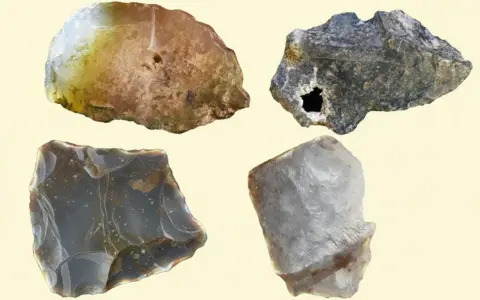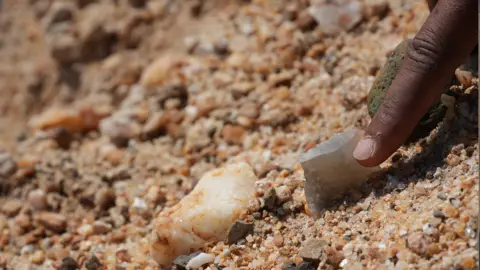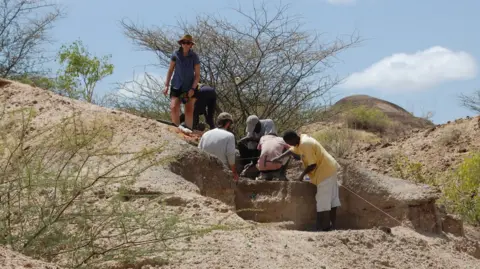
Pallab GhoshScience cancreency
 David Brown
David BrownThe first humans millions of years ago may have been inventors, according to a discovery in Northwest Kenya.
Researchers know that the first people who lived 2.75 million years ago in an archaeological site called Namorotukiman stone tools that are continuous 300,000 years.
The evidence that suggests early human tool use is sporadic: randomly developed and quickly forgotten.
Namorotukunan was the first to show that technology was passed down through thousands of generations.
According to Prof David Braun, of George Washington University, in Washington DC, who led the research, it was found, Published in the journal Nature Communicationsprovides the least compelling evidence for a radical shake-up in our understanding of human evolution.
“We thought that tool use could be a flash in the pan and then disappear. If we see 300,000 years of the same thing, that’s not possible,” he said.
“It’s a long continuum of behavior. Tool use by (humans and human ancestors) is probably much earlier and more extensive than we thought.”
 David Brown
David BrownArchaeologists spent ten years at Namorotukunan uncovering 1,300 sharp flakes, hammers, and stone shafts collected from riverbeds. It was made using a technology known as Oldowan and was the first widespread stone-making method.
The same types of devices can be found in three different layers. The deeper the layer the further back the snapshot in time. Many of the stones were specially selected for their quality, suggesting that the makers were skilled and knew what they were looking for, according to a senior geosci rolier at the University of São Palisce in Brazil.
“What we see here at the site is an incredible level of sophistication,” he told BBC News.
“These guys are very good geologists. They know how to find the best raw materials and these stone tools are amazing. Basically, we can cut some of them.”
Geological evidence suggests that tool use may have helped people survive climate changes.
The scene was moved from barren lands to dry, grasslands and semahab,” said Rahab N. Kusandanjui, senior scientist at the National Museums of Kenya.

These drastic environmental changes often force animal populations to adapt through evolution or movement. But the toolmakers of the region were able to progress by using technology instead of biological adaptation, according to Dr Palcu Rolier.
“Technology enabled the early inhabitants of East Turkana to survive in a rapidly changing landscape – not by adapting themselves, but by adapting their foraging methods.”
The evidence of stone tools in different layers shows that for a long and continuous time, these people faced the face of biological evolution, who found a way to control the world around them, instead of being controlled by the world.
And it happened at the beginning of the emergence of humanity, according to Dr. Palcu Rolier.
“The tool function means that they don’t have to evolve by changing their bodies to adapt to the changes in the bodies of eating and digging up plants.”
 David Brown
David BrownThere is evidence for this at the site: In the bones of animals that are broken, these are cut by stone tools, which means that through these changes, it can always be used for food.
“Technology gives these first swimmers an advantage, said Dr Palcu Rolier.
“They are able to access different types of food as the environment changes, their source of change changes, but because they have these challenges and can access new food.”
 David Brown
David BrownAround 2.75 million years ago, the region was inhabited by some of the first humans, with relatively small brains. These early humans are thought to have lived with their evolutionary ancestors: a group of early humans, called Austropithecines lights, with larger teeth and a mixture of characteristics.
Namorotukunan tool users are most likely one of these groups or maybe both.
And the search challenges many experts in human evolution that the continued use of the tool emerged later, among people with more brains, according to Prof. Proun.
“The argument is that we are looking at a very large increase in brain size. And often the increase is that the use of the tool allows them to feed this large brain.
“But what we saw in Namorotukunan is that these new devices were used before the increase in brain size.”
“Perhaps people are greatly reduced to early humans and human ancestors. It is true that the roots of our ability to change technology can be traced back to 195 million years ago, and perhaps even earlier.”


